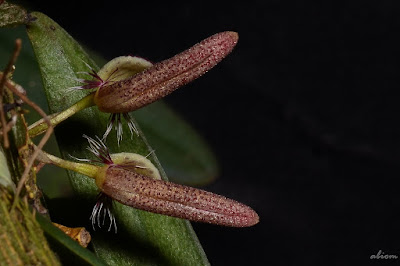Bulbophyllum mirum is native to Sumatra, Java, Bali and Borneo. A sample of this orchid was obtained in West Sumatra near the city of Padang-Panjang. In Java, this species is found only in the eastern part of the island at an altitude of 1200-1500 m.
Bulbophyllum mirum, also called as The Enchanting Bulbophyllum, Cirrhopetalum mirum, Rhytionanthos mirum, is a species of the genus Bulbophyllum. This species was described by Johannes Jacobus Smith in 1906.
IDENTIFY BULBOPHYLLUM MIRUM
Bulbophyllum mirum is native to Sumatra, Java, Bali and Borneo. The reference plant was taken in West Sumatra near Padang Panjang. In Java, they are found only in the eastern part of the island, where they are quite popular, at an altitude of 1200-1500 m, on top of Mt. Arjuno above Tretes and on top of Mt. Dworowati above Pujon. These plants also are found at Borneo, Flores, Bali and peninsular Malaysia on mossy branches and trunks at elevations around 1000 to 1600 meters.
It is a mini-miniature to miniature sized, cool growing epiphyte with a slow creeping, branching rhizome with 1" (2.5 cm) between each shortly ovoid to conical, acutely quadrangular, shiny olive green pseudobulbs carrying a single, oval to oblong, abruptly narrowing below into the very short petiolate base leaf. The leaves are dark green, but when they are young they have purple dots.
The Enchanting Bulbophyllum blooms in the summer on a basal, 5/8" to 1.1" (1.5 to 2.6 cm) long, simultaneously 2 flowered inflorescence carrying resupinate flowers. The flowers are pink with small red dots, and at the base have protruding, white "sideburns". The outermost flakes do not extend, they are up to 3.4 cm long and 0.5 cm wide. The broad-oval ridge petal is white on the underside, and on the top it has scarlet spots and has a deep pocket on the convex side, which gives it the characteristic look of a baseball cap. The upper edges are pink, with thickly scarlet spots, connected and form a tube. The small, fleshy petals of the inner whorl are almost round and are whitish, but have 7 oblong purple stripes and along the edges they have about 17 very mobile, "sideburns" appendages. These appendages are scarlet at the base and white at the tips. The lip is oblong to the egg-shaped near the base, while its apical half is narrowly triangular and is generally yellow with tiny scarlet dots.
BULBOPHYLLUM MIRUM CARE AND CULTURE
Cultural information should only be used as a guide, and should be to be adapted to suit you. Your physical location; where you grow your plants, how much time you have to devote to their care, and many other factors, will need to be taken into account. Only then can you decide on the cultural methods that best suit you and your plants.
Light:
Bulbophyllum mirum need a light level of 12000-23000 lux. The light should be filtered or dispersed, and the plants should not be exposed to direct sunlight in the afternoon hours and strong air movement should be ensured all the time.
Temperature:
It is a plant with moderate thermal requirements. Similar throughout the year - the average day temperature is 21-23 ° C, the average night temperature is 13-14 ° C, with an amplitude of daily variations of 7-9 ° C.
Humidity:
This species needs the humidity of 70-80% in summer and early autumn, decreasing in winter and at the beginning of spring to 50-60%.
Substrate, growing media and repotting:
Bulbophyllum mirum grow well attached to pieces of tree ferns or cork, as long as they can provide high humidity, which requires daily watering during the summer. In the period of extremely hot and dry weather, attached plants may require even several waterings during the day. They can also be grown in baskets using a loose, airy substrate, not decomposing too quickly, so that the roots are least likely to be disturbed.
Watering:
The Enchanting Bulbophyllum should be watered frequently during periods of intensive growth, but excellent drainage should be ensured so that the ground around the roots is never musty and soggy.
Fertilizer:
During the period of active growth, 1/4-1/2 of the recommended fertilizer dose for orchids is fed weekly. You can apply a balanced fertilizer all year round, and you can use a fertilizer with a high nitrogen content from spring to mid summer, and in late summer and fall - with a high content of phosphorus.
Rest period:
In winter, watering of Bulbophyllum mirum should be limited, but must not be allowed to stay dry for a long time. Fertilization should be reduced or eliminated until new growths appear and a more abundant spring watering begins.















COMMENTS